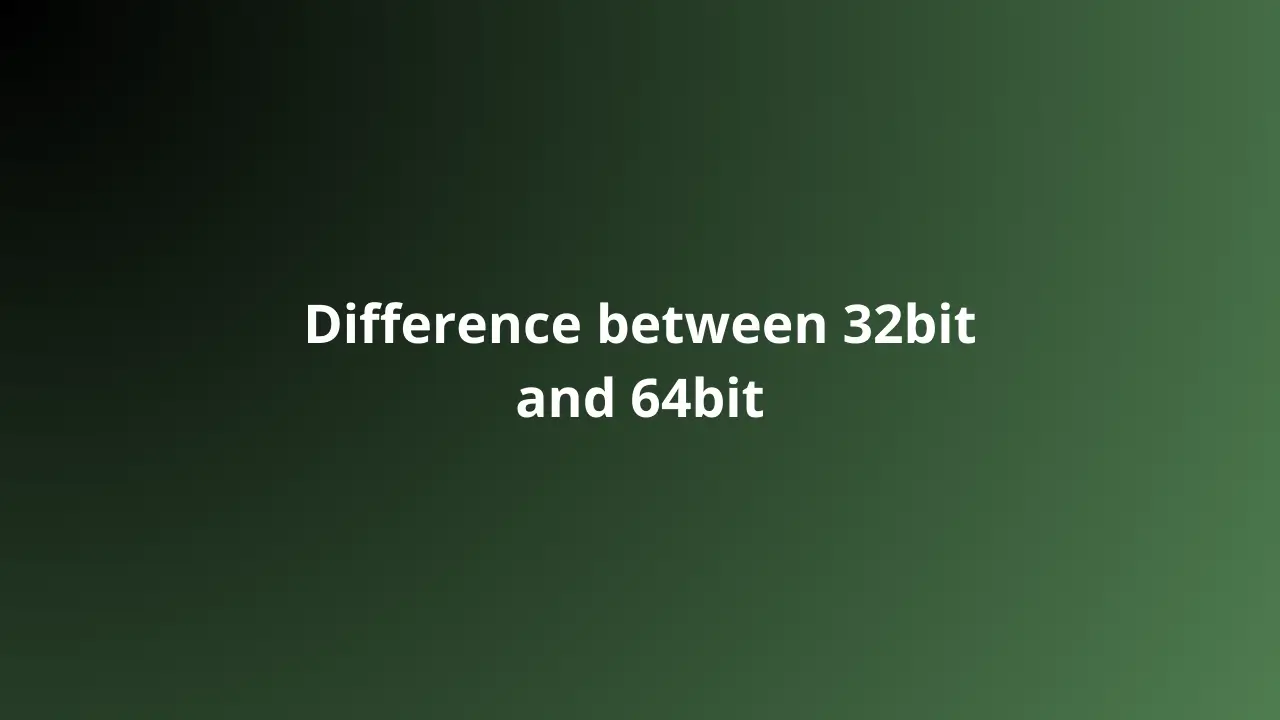Published on Jun 23, 2025
What is the Difference between 32 Bit and 64 Bit?

In the world of technology, the terms 32 bit and 64 bit often appear when we talk about hardware and software. The difference between 32 bit and 64 bit is important especially in the context of operating systems, processors, and applications used daily. Understanding this difference is not only useful for ordinary computer users, but also crucial for software developers, system administrators, and cybersecurity activists.
This article will discuss in depth what 32 bit and 64 bit are, the history of their development, the basic differences between the two, and how they impact computer performance and the choice of operating systems we use. With a detailed and complete explanation, you will understand why this difference is important and how to choose the most appropriate system for your needs.
Understanding 32 Bit and 64 Bit
Before discussing further about the differences between 32 bit and 64 bit, it is important to first understand what the term “bit” itself means.
What is Bit?
Bit stands for Binary Digit, which is the smallest unit in the binary number system used in computing. The binary system consists of two basic values, namely 0 and 1. In the context of computer architecture, bits refer to the amount of data that can be processed by the processor at a given time.
For example:
- If a processor has a 32-bit architecture, then it is capable of processing 32 bits of data in one instruction cycle.
- If a processor has a 64-bit architecture, then it is capable of processing 64 bits of data in one instruction cycle.
The greater the number of bits that can be processed, the more data can be processed simultaneously, which has the potential to increase the speed and efficiency of the overall system performance.
Understanding 32 Bits
32-bit architecture is a type of processor that is capable of handling data and memory addresses with a width of 32 bits. A 32-bit processor means that the width of the registers, data buses, and memory addresses that can be accessed by the system is 32 bits or equivalent to 2³² unique values.
In other words, a 32-bit processor can access up to:
2^{32} = 4,294,967,296 \text{ unique addresses} = 4 GB \text{ maximum RAM memory}
Thus, a 32-bit processor can theoretically only handle up to 4 GB (gigabytes) of physical memory. If the RAM in your system is more than 4 GB, a 32-bit processor will only recognize and use a maximum of 4 GB.
Understanding 64 Bit
A 64-bit architecture is a type of processor that can handle data and memory addresses with a width of 64 bits. 64-bit processors have the ability to access memory up to 2⁶⁴ unique values or approximately:
2^{64} = 18,446,744,073,709,551,616 \text{ unique addresses} = 16 EB \text{ (exabyte)}
In theory, a 64-bit processor can support up to 16 exabytes of RAM memory. However, the memory limits that can be used by commonly available operating systems today are usually limited to 128 GB to 2 TB depending on the version of the operating system.
- Faraday Kali Linux: The Complete Guide to Integrated Security Analysis
- What are the Main Duties of a System Analyst in the World of Information Technology?
- Cybersecurity Stocks: An Investment Opportunity in the Ever-Evolving Digital Age
- Most Dangerous Types of Malware Viruses
- Best Privacy-Focused Alternatives to Google
Due to the much larger memory capacity, 64-bit processors allow systems to run more complex applications and process large amounts of data more quickly and efficiently.
Basic Differences Between 32 Bit and 64 Bit
Here are some of the main differences between 32-bit and 64-bit processors and operating systems:
| Aspects | 32 Bit | 64 Bit |
|---|---|---|
| Data Size Processed | 32 bits in one cycle | 64 bits in one cycle |
| Maximum RAM | 4 GB | Up to 16 EB (OS dependent) |
| Performance | Slower for heavy tasks | Faster and more efficient |
| Software Compatibility | Supports 32-bit applications only | Supports both 32-bit and 64-bit applications |
| Security | Basic security, no additional features | Supports additional security features such as DEP and ASLR |
| Operating System Type | Supports only 32-bit OS | Supports both 32-bit and 64-bit OS |
| Multitasking Capability | Limited by RAM limitations | Better at handling multiple applications at once |
| Virtualization | Limitations on memory allocation | Supports full virtualization with large memory |
Advantages and Disadvantages of 32 Bit vs 64 Bit
Advantages of 32 Bit
- Compatibility with older devices.
- Lighter for systems with low specifications.
- There are still many old applications that only support 32 bit.
Disadvantages of 32 Bit
- Cannot use more than 4 GB of RAM.
- Limited multitasking performance.
- Does not fully support modern security features.
Advantages of 64 Bit
- Supports up to 16 EB of RAM (in theory).
- Faster performance in processing large data.
- Supports modern security features such as ASLR and DEP.
- Able to run 32 bit and 64 bit applications.
Disadvantages of 64 Bit
- Not all 32 bit applications can run on 64 bit systems.
- Requires hardware with higher specifications.
Impact of 32 Bit and 64 Bit Differences in Daily Use
Operating System
- 32 bit operating systems can only be installed on 32 bit processors.
- 64 bit operating systems can be installed on 64 bit processors and support 32 bit and 64 bit applications.
Performance
- On 32 bit processors, data processing is limited so performance will be slower when handling heavy tasks.
- 64 bit processors can process more data simultaneously, so performance is faster.
Games and Applications
- Modern games and applications usually require a 64 bit system because they require more memory and high performance.
- Old 32 bit based applications may not run on a 64 bit operating system without an emulator.
How to Know if Your Operating System is 32 Bit or 64 Bit?
- Windows
- Click Start → Settings → About
- Look at the System Type section
- Linux
- Open a terminal, type:
uname -m
- If the output is
x86_64, then your system is 64 bit. Ifi386ori686, then your system is 32 bit.
- MacOS
Click Apple Menu → About This Mac
Conclusion
The main difference between 32 bit and 64 bit lies in the amount of data that can be processed at one time and the RAM capacity supported. 64 bit processors and operating systems offer better performance, support more memory, and have more advanced security features. If your hardware supports 64-bit architecture, it is highly recommended to use a 64-bit operating system for optimal performance.





